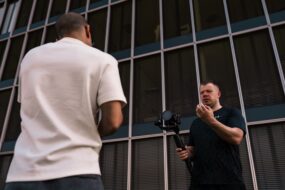
Storytelling has been an intrinsic part of human culture since the dawn of civilization. It is a powerful tool that allows us to communicate ideas, share experiences, and connect with one another on a deeper level. As I delve into the world of storytelling frameworks, I realize that these structures serve as blueprints for crafting narratives that resonate with audiences.
They provide a roadmap that guides me through the intricate process of storytelling, ensuring that my message is not only clear but also engaging. In a world saturated with information, the ability to tell a compelling story can set me apart. Whether I am writing a novel, creating a marketing campaign, or simply sharing a personal experience, understanding various storytelling frameworks can enhance my narrative.
Each framework offers unique elements that can be tailored to fit my specific needs, allowing me to create stories that captivate and inspire. As I explore these frameworks, I find that they not only help in organizing my thoughts but also in evoking emotions and fostering connections with my audience.
Key Takeaways
- Storytelling frameworks provide a structured approach to crafting compelling narratives for brands.
- The Hero’s Journey offers a powerful narrative structure that resonates with audiences on a deep level.
- The Three-Act Structure helps build tension and resolution in brand storytelling, keeping audiences engaged.
- The Five Ws framework ensures that brand stories are clear, engaging, and answer key questions for the audience.
- The Monomyth unites cultures through universal themes, making brand stories relatable to diverse audiences.
The Hero’s Journey: Crafting a Compelling Narrative
One of the most celebrated storytelling frameworks is the Hero’s Journey, a concept popularized by Joseph Campbell. This framework outlines a universal pattern that many stories follow, where a hero embarks on an adventure, faces challenges, and ultimately returns transformed. As I consider this structure, I recognize its power in creating relatable characters and compelling narratives.
The journey resonates with audiences because it mirrors our own experiences of growth and transformation. In my storytelling endeavors, I often find myself drawing inspiration from the Hero’s Journey. By establishing a protagonist who faces adversity, I can create tension and intrigue.
The hero’s call to adventure serves as a catalyst for change, pushing them out of their comfort zone. As I develop the narrative, I ensure that the hero encounters mentors, allies, and obstacles that shape their journey. This not only adds depth to the character but also allows me to explore themes of resilience and courage.
Ultimately, the hero’s return home signifies not just a physical journey but an emotional one, making the story profoundly impactful.
The Three-Act Structure: Building Tension and Resolution

Another effective storytelling framework is the Three-Act Structure, which divides a narrative into three distinct parts: setup, confrontation, and resolution. This structure provides a clear path for developing tension and delivering satisfying conclusions. As I apply this framework to my storytelling, I find that it helps me maintain focus and pacing throughout the narrative.
In the first act, I introduce my characters and establish the setting, laying the groundwork for the story. This is where I hook my audience by presenting an intriguing premise or conflict. The second act is where the tension escalates; my protagonist faces challenges that test their resolve.
This act is crucial for character development, as it reveals their strengths and weaknesses. Finally, in the third act, I bring the story to a climax and resolution. This structure not only keeps my audience engaged but also ensures that the narrative feels complete and satisfying.
The Five Ws: Creating a Clear and Engaging Story
The Five Ws—who, what, when, where, and why—are fundamental questions that guide me in crafting a clear and engaging story. By addressing these elements early on, I can provide my audience with essential context and information. This framework encourages me to think critically about my narrative and ensures that I am not leaving any gaps in understanding.
When I begin to outline my story using the Five Ws, I start with “who.” Identifying my characters helps me establish their motivations and relationships. Next comes “what,” which defines the central conflict or event driving the narrative forward. The “when” and “where” provide temporal and spatial context, grounding my story in reality.
Finally, “why” delves into the underlying themes and messages I wish to convey. By systematically addressing these questions, I create a cohesive narrative that captivates my audience from start to finish.
The Monomyth: Uniting Cultures through Universal Themes
The concept of the Monomyth extends beyond individual stories; it highlights the shared human experience across cultures. This framework emphasizes universal themes such as heroism, sacrifice, and transformation that resonate with people regardless of their background. As I explore the Monomyth in my storytelling, I recognize its potential to foster empathy and understanding among diverse audiences.
Incorporating elements of the Monomyth into my narratives allows me to tap into collective archetypes that evoke strong emotional responses. By weaving in themes of struggle and triumph, I create stories that transcend cultural boundaries. This approach not only enriches my storytelling but also invites readers from different walks of life to connect with the characters and their journeys.
Ultimately, the Monomyth serves as a reminder of our shared humanity and the power of storytelling to bridge divides.
The Freytag’s Pyramid: Adding Drama and Climax to Your Brand Story

Freytag’s Pyramid is another valuable framework that enhances dramatic storytelling by outlining five key elements: exposition, rising action, climax, falling action, and resolution. This structure allows me to build tension effectively while guiding my audience through an emotional rollercoaster. As I apply Freytag’s Pyramid to my brand story, I find that it helps me create a narrative arc that captivates and engages.
In the exposition phase, I introduce my brand’s identity and values, setting the stage for what is to come. The rising action involves presenting challenges or conflicts that my brand has faced or aims to address. This is where I can showcase resilience and innovation, drawing my audience into the narrative.
The climax represents a turning point—perhaps a breakthrough moment or a significant achievement—that highlights my brand’s impact. Following this peak, the falling action allows me to reflect on lessons learned and growth experienced before arriving at a satisfying resolution that reinforces my brand’s mission.
The Pixar Pitch: Crafting a Memorable and Emotional Brand Narrative
The Pixar Pitch is a unique storytelling framework that emphasizes simplicity and emotional resonance. It distills complex narratives into concise statements that capture the essence of a story while evoking feelings in the audience. As I explore this approach for crafting my brand narrative, I appreciate its focus on clarity and emotional connection.
To create a Pixar Pitch for my brand story, I start by identifying key elements: “Once upon a time,” “every day,” “one day,” “because of that,” “because of that,” and “until finally.” This structure encourages me to distill my brand’s journey into a compelling narrative arc that highlights challenges faced and victories achieved. By focusing on emotional moments—whether it’s overcoming adversity or making a positive impact—I can create a memorable story that resonates with my audience on a personal level.
Choosing the Right Storytelling Framework for Your Brand
As I reflect on the various storytelling frameworks I’ve explored, I realize that each one offers unique advantages depending on my goals and audience. Whether I’m crafting an epic tale using the Hero’s Journey or building tension through Freytag’s Pyramid, understanding these frameworks empowers me to tell stories that resonate deeply with others. Ultimately, choosing the right storytelling framework for my brand involves considering what message I want to convey and how best to engage my audience.
By blending elements from different frameworks or adapting them to suit my narrative style, I can create stories that are not only compelling but also authentic to my brand’s identity.
FAQs
What are storytelling frameworks?
Storytelling frameworks are structured approaches to crafting and presenting a narrative. They provide a framework for organizing and communicating a story in a compelling and effective way.
How can storytelling frameworks enhance brand narrative?
Storytelling frameworks can enhance brand narrative by providing a clear structure for communicating the brand’s values, mission, and unique selling points. They help create a cohesive and engaging story that resonates with the audience.
What are some common storytelling frameworks used in branding?
Some common storytelling frameworks used in branding include the hero’s journey, the three-act structure, the problem-solution framework, and the before-after-bridge framework. Each framework offers a different approach to crafting and presenting a brand narrative.
How can businesses use storytelling frameworks to connect with their audience?
Businesses can use storytelling frameworks to connect with their audience by creating narratives that are relatable, emotional, and memorable. By using a structured approach to storytelling, businesses can effectively communicate their brand message and build a strong connection with their audience.
What are the benefits of using storytelling frameworks in branding?
The benefits of using storytelling frameworks in branding include creating a consistent brand narrative, engaging and captivating the audience, differentiating the brand from competitors, and building a strong emotional connection with customers. Storytelling frameworks also help in simplifying complex brand messages and making them more accessible to the audience.










No Comments